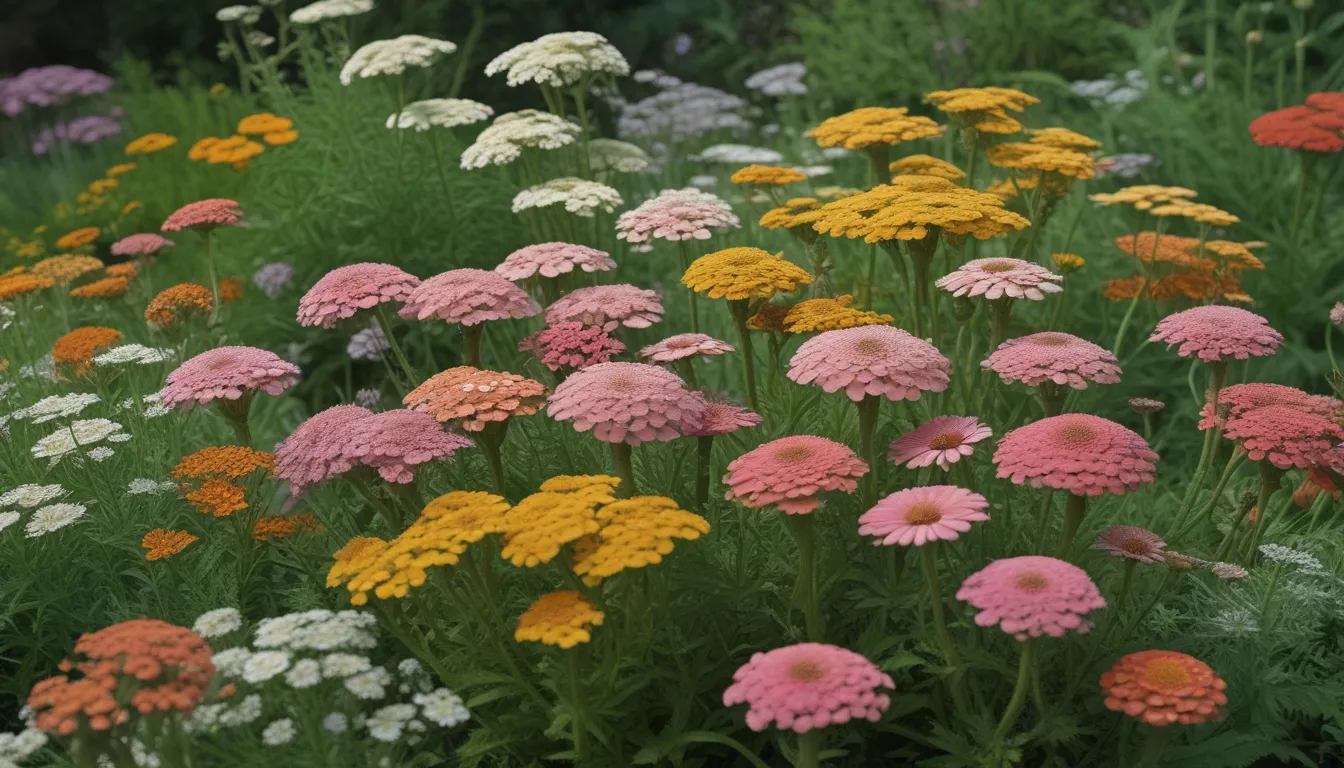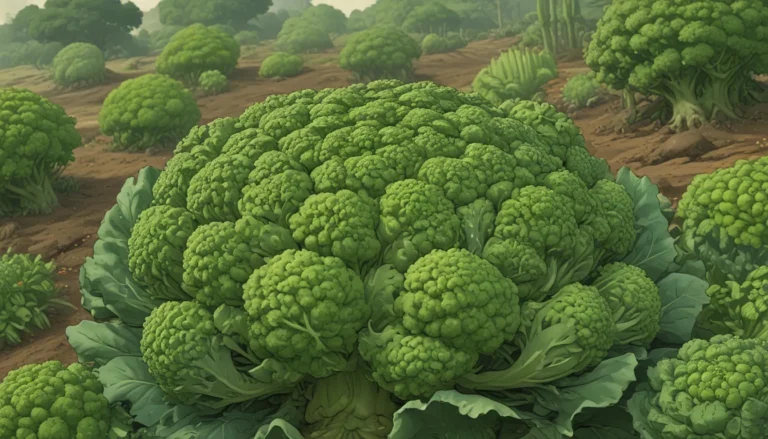Transforming Your Garden with Yarrow: A Comprehensive Guide to Growing and Caring for Achillea spp.

Yarrow, also known as Achillea spp., is a stunning semi-evergreen flowering perennial that belongs to the aster, or Asteraceae family. With its corymb, or flattened, flower heads boasting densely clustered blossoms in shades of pink, red, white, and yellow, this plant is a delightful addition to any garden. Whether you’re a seasoned gardener or just starting out, cultivating and caring for yarrow is a rewarding experience that offers vibrant colors with minimal water and maintenance requirements.
In this detailed guide, we’ll dive deep into all the essential information you need to know to successfully grow and maintain yarrow in your garden. From its rich history and cultivation practices to tips for growing, pruning, and selecting the right cultivars, we’ve got you covered!
The Fascinating History and Cultivation of Yarrow
In ancient Europe and Asia, yarrow was a versatile plant with a wide range of uses, including artistic, cosmetic, culinary, medicinal, and even magical applications. Legend has it that Achilles of Troy used yarrow to treat his wounded soldiers, highlighting its historical significance.
Fast forward to the present day, where yarrow continues to be valued for its culinary, floral design, and herbal remedy applications. With nearly 100 species in the Achillea genus, yarrow thrives best in USDA Hardiness Zones 3 to 9. Hybridization of various species like A. clypeolata, A. filipendulina, A. millefolium, A. ptarmica, and A. taygetea has led to the development of many modern cultivars known for their large blooms and diverse colors.
The two most common species you’re likely to encounter are A. millefolium and A. filipendulina, each distinguished by unique characteristics like flower size, color, and height. It’s essential to be aware of any potential invasiveness of A. millefolium in your region, as its vigorous spreading nature can pose challenges in some areas.
Propagating Yarrow with Ease
When it comes to growing yarrow in your garden, you have several propagation options to choose from. Whether you prefer starting from seeds, dividing existing plants, or taking tip cuttings, each method has its unique advantages. Here’s a breakdown of each propagation method:
From Seed
- Start seeds indoors in February or March for first-year flowering.
- Sow seeds directly in the garden after the last frost date.
- Provide optimal conditions for germination and growth, including suitable temperatures and moisture levels.
- High nitrogen fertilization can promote robust seedling development.
By Division
- Divide mature plants in early spring for quick propagation.
- Select healthy plant sections with multiple stems for best results.
- Plant divisions elsewhere in the garden or share with friends to spread the beauty of yarrow.
From Tip Cuttings
- Take cuttings from soft spring growth for propagation.
- Root cuttings in a suitable potting medium.
- Transplant rooted cuttings into the garden for continued growth and development.
By choosing the right propagation method based on your preferences and garden conditions, you can easily expand your yarrow collection and enjoy its blooms year after year.
Cultivating Yarrow for Optimal Growth
Yarrow is a hardy, cold- and drought-tolerant perennial that thrives in full sun with well-draining sandy soil. Unlike some plants, it doesn’t have a preference for organically-rich loam and can adapt well to average to poor soil quality. When cultivating yarrow, consider the following key points for successful growth:
- Provide full sun exposure for optimal flowering.
- Choose sandy soil with good drainage to prevent waterlogging.
- Maintain soil pH between 4.0 and 8.0, with 6.4 considered ideal.
- Water new plants regularly to establish strong roots and ensure healthy growth.
With its ability to withstand dry heat and thrive in challenging conditions, yarrow is a low-maintenance powerhouse that adds vibrant colors to your garden throughout the summer months.
Helpful Tips for Growing Yarrow Successfully
To maximize the growth and beauty of your yarrow plants, keep these essential tips in mind:
- Select humidity-tolerant cultivars if needed for your region.
- Opt for poor soil to promote compact growth at a moderate rate.
- Water new plants adequately during dry spells to support healthy establishment.
By following these tips, you can ensure that your yarrow plants thrive and reward you with years of colorful blooms without requiring excessive care.
Pruning and Maintenance Made Easy
While yarrow is a low-maintenance plant, some basic pruning and maintenance practices can help you keep your plants healthy and vibrant. After establishing your plants with thoughtful care and attention, you can follow these maintenance tips:
- Water plants as needed, especially during prolonged dry periods.
- Prune yarrow plants deeply after the first flush of flowers to maintain shape and promote additional blooming.
- Deadhead spent flowers regularly to prevent self-sowing and encourage continuous blooming.
By incorporating these habits into your gardening routine, you can enjoy healthy, beautiful yarrow plants that enrich your garden with their vibrant colors and lush foliage.
Discovering the Beauty of Yarrow Cultivars
As you explore the world of yarrow cultivation, you’ll encounter a wide range of cultivars with unique characteristics and colors. Here are three popular yarrow cultivars to consider for your garden:
Cerise Queen
- Features deep pink flowers with white centers.
- Retains rich color even in summer heat.
- Compact growth habit with feathery medium-green foliage.
Gold Plate
- Boasts large mustard-yellow flower heads.
- Tall stems with fern-like silvery green basal leaves.
- Ideal for adding vibrant color to your garden landscape.
Paprika
- Displays brick red flowers with gold centers.
- Suitable for more humid climates.
- Medium-sized flowers with feathery basal foliage.
Whether you prefer classic white blooms or vibrant hues like deep pink and brick red, yarrow cultivars offer a diverse range of options to enhance your garden’s aesthetic appeal.
Managing Pests and Disease Effectively
While yarrow is generally resistant to pest and disease issues, maintaining healthy plants is essential to prevent infestations and infections. By following these guidelines, you can minimize the risk of common problems such as aphids, mealybugs, spittlebugs, and fungal diseases:
- Ensure plants are stress-free with optimal growing conditions.
- Address pests like aphids with insecticidal soap or neem oil.
- Treat fungal infections promptly with appropriate fungicides.
By staying vigilant and proactive in managing pests and diseases, you can protect your yarrow plants and maintain their vibrant appearance throughout the growing season.
Best Uses for Yarrow Plants in Your Garden
Yarrow plants offer versatile benefits beyond their ornamental beauty, making them valuable additions to various garden settings. Here are some key uses for yarrow in your garden:
- Plant in beds, butterfly gardens, containers, and mixed borders.
- Use yarrow as a natural pest repellent to deter insects and herbivores.
- Incorporate low-growing varieties as a ground cover alternative to grass.
- Pair with other xeriscape plants for a low-water, low-maintenance garden design.
Whether you’re creating a serene butterfly garden or adding color to a sunny meadow, yarrow plants are adaptable and versatile companions that enrich your garden’s ecosystem.
Quick Reference Growing Guide for Yarrow
To help you quickly reference essential information about yarrow cultivation, we’ve provided a convenient summary below:
- Plant Type: Herbaceous perennial herb
- Flower/Foliage Color: Pink, red, white, yellow; mid-green, silver-green
- Native to: Asia, Europe, North America
- Water Needs: Low
- Hardiness (USDA Zone): 3-9
- Maintenance: Low
- Season: Late spring, summer
- Soil Type: Sandy, average to poor
- Exposure: Full sun
- Soil pH: 4.0-8.0; 6.4 best
- Growth Rate: Moderate to fast
- Soil Drainage: Well-draining
- Spacing: 1-3 feet
- Companion Planting: Bee balm, calamint, catmint, coneflower, eryngium, globe amaranth, herbs, lavender, sage, salvia, small globe thistle, vegetables
- Attracts: Beneficial pollinators, birds
- Height: 2-4 feet
- Spread: 1-3 feet
- Tolerance: Cold, drought, heat, poor soil, salt, wind
- Pests & Diseases: Aphids, mealybugs, spittlebugs; Botrytis blight, leaf spot, parasitic nematodes, powdery mildew, root rot, rust, stem rot
With this quick reference guide, you can easily access vital information to support the successful growth and care of yarrow plants in your garden.
Embracing the Beauty of Yarrow in Your Garden
Transforming your garden with the vibrant colors and lush foliage of yarrow plants is a rewarding endeavor that offers lasting beauty and benefits. With its resilience, low-maintenance nature, and versatile applications, yarrow is an excellent choice for gardeners of all levels.
Whether you’re seeking to attract pollinators, repel pests, or enhance the aesthetics of your garden, yarrow plants provide a wealth of possibilities to explore. By following our comprehensive guide and incorporating best practices for cultivation and care, you can experience the joy of growing and caring for yarrow in your own garden.
So, why not add a touch of elegance and charm to your outdoor space with the timeless beauty of yarrow? Discover the wonders of this versatile perennial herb and watch as your garden transforms into a colorful oasis that delights the senses and uplifts the spirit.
Stay Connected for More Gardening Tips and Inspiration
For more insightful articles, gardening tips, and inspiration, be sure to stay connected with us. Follow our website for a wide range of topics, from growing herbs and vegetables to creating stunning floral arrangements and landscaping designs. Join our community of passionate gardeners and discover the endless possibilities awaiting you in the world of gardening.
Disclaimer: This article is intended for educational purposes only. Always consult local gardening resources and extension services for specific advice tailored to your region and garden conditions. The information provided in this article is based on research and expertise to offer general guidance for cultivating and caring for yarrow plants.





